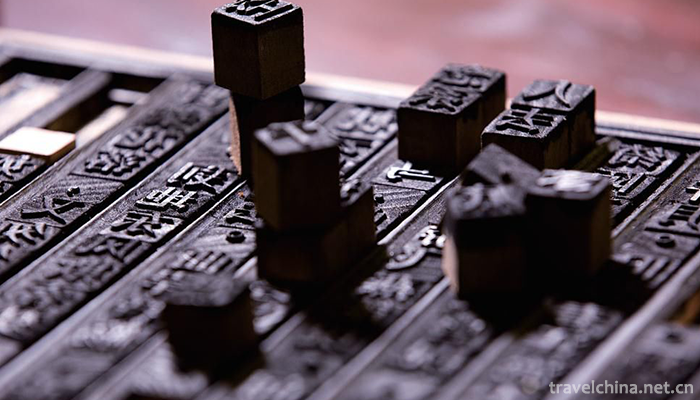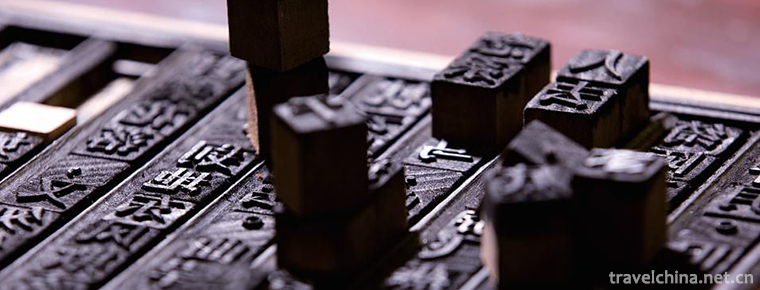Wood movable type printing technology
Wood movable type printing technology
Wood movable type printing technology, the local traditional technology of Ruian City, Zhejiang Province, is one of the national intangible cultural heritage.
Dongyuan Village is located in the southwest of Ruian City, Zhejiang Province. According to the local "Wang's genealogy of Taiyuan County", in the early Yuan Dynasty, Wang Famao, a hermit in Anxi County, Fujian Province, began to introduce the technology of wood movable type printing into the genealogy compilation of clans (clans). The art of "Zi Ji" (the process of using wood movable type printing to compile genealogy) came into being and has been inherited from generations to generations. During the reign of Zhengde in Ming Dynasty, some descendants of Wang Famao moved from Fujian to Pingyang in Zhejiang Province. In the first year of Qianlong in the Qing Dynasty (1736), Wang Famao V's grandson Yingzhong led his descendants from Pingyang to Dongyuan. The art of Ziji took root in Dongyuan and has been handed down to this day.
In June 2008, wood movable type printing technology was approved by the State Council and listed in the second batch of national intangible cultural heritage list, project number_-135. On November 15, 2010, Rui'anmu movable-type printing technology, in the name of Chinese movable-type printing, was listed on the list of "the urgent need to protect intangible cultural heritage" in the world.
historical origin
According to the genealogy of Wang clan in Taiyuan County, the ancestors of Wang clan originally lived in Henan Province. At the end of the Five Dynasties, Wang Chao and Wang Juzhi brothers moved to Fujian, and then one of them moved to Anxi County, Fujian Province. In the early Yuan Dynasty, Wang Famao, who lived in seclusion in Taili, Anxi County, Fujian Province, began compiling genealogy and printing genealogy in movable wood. From then on, Wang's "Zi Ji" (printing and editing) art came out. During the reign of Ming Zhengde (1506-1521), some descendants of Wang Famao moved from Fujian to Puwei and Xiangyuan of Pingyang, Zhejiang. In the first year of Qianlong (1736), Wang Yingzhong led his descendants from Pingyang Xiangyuan to Ruian Dongyuan. Wang Famao's "Zi Ji" art took root in Dongyuan Village and was inherited from dynasties to dynasties. The enlightened Wang genealogist imparted his skill of printing and printing genealogy with wood movable type to his relatives and friends in the same village, and even to scholars in other counties. In this way, Wu, Pan, Zhang and other surname residents also learned the art of "Zi Ji".
Technological characteristics
Re-assembly leads to the reuse of layout components, so printing the same text or graphics on different pages is the unique technological feature of movable type typesetting which is different from other printing methods. The inner parts of movable-type plate, such as top wood and clamping strips, sometimes leave traces on the plate, which is also the unique technological characteristics of movable-type printing.
Technological process
Wood movable type printing is closely related to the compilation of genealogy. The basic production process is: Kaiding (interview) clearing drafting checking typesetting proofreading brushing circle scribbling typesetting drafting spectrum cutting binding line cover binding. Usually, we need to do a good job in the basic work of drawing materials, making fonts, writing (opposite fonts), engraving and so on. Take a good tangerine pear wood, after rain, sun and natural drying, make a type, engrave Song style, and make one by one wooden movable characters for typesetting.
Inheritance and Protection
Inheritance value
Ruian Wood Movable Type Printing is the only known and still used technology of Wood Movable Type Printing in China. It has a good historical and humanistic value and is a physical proof that Movable Type Printing originated in China.
Current situation of inheritance
With the rapid development of mechanized printing, there are few successors of Dongyuan wood movable-type printing technology, such as engraving, printing and so on. It is on the verge of extinction and needs to be protected urgently.
Heritage figures
Lin Chuyin, male, was born in April 1938. In April 2010, Lin Chuyin was selected as the representative successor of the third batch of national intangible cultural heritage projects: wood movable type printing technology.
Wang Chaohui, male, was born in December 1955. In April 2010, Wang Chaohui was selected as the representative successor of the third batch of national intangible cultural heritage projects: wood movable type printing technology.
protective measures
In June 2004, Ruian City built the first Chinese Wood Movable Type Printing Culture Exhibition Hall (old hall), 13 years later, the new hall was completed. The new exhibition hall covers an area of 540 square meters and a building area of 1013 square meters. The whole exhibition hall has reception rooms, exhibition halls, exhibition halls for the whole process of wood movable type printing, visitor experience halls and so on. It fully demonstrates the whole operation process of the ancient "wood movable type printing".
social influence
Important exhibitions
On June 9, 2007, Wenzhou Municipal Exhibition Hall exhibited "Wenzhou Rural Ethnic Folk Art Exhibition". Some old folk traditions gradually fading out of people's lives appeared before you. Ruian's "movable-type printing" exhibition has become the highlight of the first Wenzhou Peasant Culture and Art Festival.
Social activities
On November 27, 2017, Ruian City held a seminar on the cultural industry and tourism development of wood movable type printing in China (Ruian). At the seminar, Dr. Zhang Ji, Director of Institute of Modern Publishing, School of Journalism and Communication, Peking University, Ms. Zhao Chunying, Director of Collection Management and Associate Research Librarian of China Printing Museum, Dr. Peng Junling, Research Librarian of Beijing Printing College, Wang Xiaoming, Associate Professor of China Academy of Fine Arts, Master Tutor, and Hu Nianwang, Director of Office of Wenzhou Tourism Bureau, made "Zhejiang Province". With Ancient Movable-type Printing, New Times, New Objectives of Traditional Culture Development: Reflections on Renovation of the Exhibition Hall of Dongyuan Chinese Wood Movable-type Printing Culture Village, Thoughts on Protection, Inheritance and Development and Utilization of Wood Movable-type Printing, Civilization Inheritance and Future Hope: Multi-interaction between Chinese Wood Movable-type Printing and Contemporary Chinese Character Ink Art, and Wood Mova Speech on the theme of "Tourism Industry Development".


-
1.Portuguesestyle egg tarts
Portuguese egg tart, also known as Portuguese cream tower, caramel Mejit egg tart. Portuguese tart, known in Hong Kong, Macao and Guangdong, is a small cream pastry pie.
Time 2018-10-31 -
2.Mung bean soup
Mung bean soup is a soup boiled with mung bean and water as the main ingredients. It has the functions of clearing heat, detoxifying, quenching thirst and relieving heat
Time 2018-11-02 -
3.XiShuangBanNa Tropical Botanical GardenChines
Xishuangbanna Tropical Botanical Garden of the Chinese Academy of Sciences, National AAAAA Tourist Scenic Area, is located in Huludao, Mengla Town, Mengla County
Time 2018-12-12 -
4.Chongqing Yunyang Longgang National Geological Park
Yunyang Longgang Scenic Spot: National AAAAA Class Tourist Spot, National Geopark and National Day 2016 "Best Tourist Service Scenic Spot"
Time 2018-12-12 -
5.Yunnan Wildlife Park
Yunnan Wildlife Park is located in Qingshuihe Village, Fengyuan Road, Panlong District, Kunming City (beside Yunnan Forestry Department), 10 kilometers from the urban center of Kunming City
Time 2018-12-22 -
6.Production Techniques of Black Tea
Qimen Black Tea is the only black tea among the top ten famous teas in China. It is produced in Qimen County, Anhui Province. Tea production in Qimen has a long history, which can be
Time 2019-05-03 -
7.Boxwood carving
Boxwood carving is one of the traditional folk carving arts in Zhejiang Province. It uses boxwood as carving material and uses the natural form of boxwood, which is smooth, delicate in texture and sol
Time 2019-05-04 -
8.Drama Costume and Opera Production Skills
Drama costume and costume production skills, local traditional handicraft in Suzhou City, Jiangsu Province, one of the national intangible cultural heritage.
Time 2019-05-08 -
9.Kuozi Guzi
Guzi, also known as "Guzi Dance" and "Cowskin Boat Dance", is a unique folk dance of two groups of Junba in Chabalang Village, Qushui County, Tibet Autonomous Region. In 2008
Time 2019-05-10 -
10.Mao Qiang
Maoqiang is a local opera popular in Weifang, Qingdao, Rizhao and other places. It was originally a folk humming tune called "Zhou Gu Tune". Legend has it that Maoqiang was named after a nun
Time 2019-05-30 -
11.Luzhou scenic spots
Luzhou has a long history, profound cultural accumulation, strong ethnic customs and rich tourism resources, forming five characteristic tourism resources represented by famous wine culture, ecological culture, red culture, historical culture and Yangtze River culture. By the end of 2016
Time 2020-12-14 -
12.History of Guangan
Guang'an belonged to Liangzhou in ancient times and Yongzhou in Yin and Shang Dynasties. In the fifth year of King Shenliang of Zhou Dynasty (316 BC), Qin destroyed Bashu and established Ba and Shu counties. Today, Guang'an District, Qianfeng District, Linsh
Time 2020-12-19